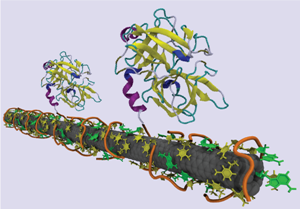Since they were first developed a quarter-century ago, carbon nanotubes (CNTs) have impressed scientists with their mechanical strength and stiffness, their optical performance, and their ability to conduct heat and electricity.

A carbon nanotube (CNT) can be as narrow as 1 nanometer in diameter, but its length can measure in the hundreds or thousands of nanometers. One nanometer is a billionth of a meter, or between one ten-thousandth and one hundred-thousandth the thickness of a human hair.
CNTs are used in a variety of applications, from clothing and sporting equipment to building materials, photovoltaic cells, batteries, electronic devices and even automobile tires.
Dan Roxbury 07, 12G sees another potential use for the tiny tubes. One day, he hopes, CNTs will be inserted in the human body to serve as an early warning system to detect and treat cancer.
Roxbury, who holds a B.S. and Ph.D., both in chemical engineering, recently received a $150,000 grant from the American Cancer Society to further his work as a research fellow at the Memorial Sloan-Kettering Institute for Cancer Research in New York.
There, according to an article on the ACS website, Roxbury is building a sensor made of CNTs wrapped with strands of DNA that can detect in the bloodstream the amount of a biomarker called urokinase plasminogen activator (uPA) that signals the presence and progression of some types of cancer.
The sensing agent in Roxbury’s sensor is the uPA binding antibody, which is attached to the CNT-DNA hybrid wrap and detects the uPA.
The DNA he uses is synthetic. The width of each strand is roughly the same as the diameter of the nanotubes, while their length is shorter than that of the CNTs. Several strands wrap around an individual CNT. After modifying the end of each DNA strand as well as the antibody, Roxbury uses a type of synthesis called click chemistry to induce the strand and the antibody to bond to each other.
“Nanotubes are very sensitive to their environment, which makes them very good sensors,” Roxbury told ACS. “The antibody conveys the message to the nanotube and the nanotube gives a readout of how much of the uPA molecule is detected.”
Roxbury is testing his CNT device in water and hopes soon to conduct tests in blood or another complex solution and then in mice.Eventually, he foresees the device being inserted noninvasively under the skin of people who are at risk for cancer or have had the disease. A smart watch or smartphone would pick up signals from the CNT device and monitor the level of the cancer biomarker in the bloodstream.
Roxbury first became interested in CNTs when he chose Anand Jagota, the Robert W. Wieseman 1916 Endowed Engineering Chair in Chemical Engineering, as his Ph.D. adviser. Jagota, who directs Lehigh’s bioengineering and life sciences program, has been studying CNT-DNA hybrids for more than a decade.
“I picked Prof. Jagota because his work with nanotubes sounded very interesting and unlike many other traditional ChemE research projects,” says Roxbury.
Together with Jagota, Roxbury studied the interactions and binding of DNA and CNTs, and the unique and novel helical structures that they form.
“Prof. Jagota is very inspiring to his students,” says Roxbury. “He is one of the best teachers I have ever had. He really cares about teaching. He takes the time to make sure you understand what he is telling you.”
Roxbury also worked closely with Jeetain Mittal, the P.C. Rossin Assistant Professor of Chemical and Biomolecular Engineering, performing numerical simulations to study the interactions of DNA and CNTS. The two coauthored several papers, including two published in Nano Letters and one in the Journal of the American Chemical Society.
Roxbury Ph.D. thesis is titled “Sequence-Dependent Interactions between DNA and Single-Walled Carbon Nanotubes.”
He says his Lehigh education prepared him well to work with researchers from diverse backgrounds.
“At Lehigh, I was trained in chemical engineering and bioengineering. There are a lot of biologists and medical doctors at Sloan Kettering, but not many engineers. It is good to have an alternative way of thinking in a group like ours. With a diverse group, you get a lot of innovative ideas.
“Lehigh definitely prepared me for the kind of interdisciplinary work I am doing here.”
